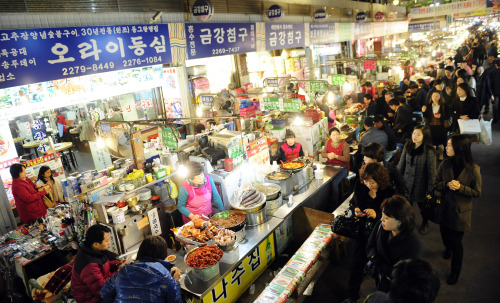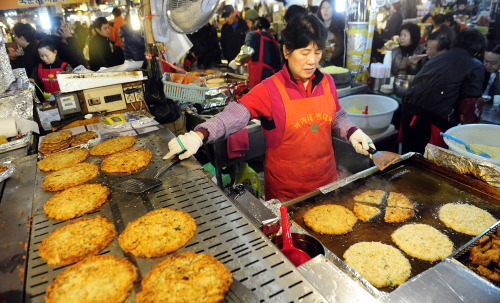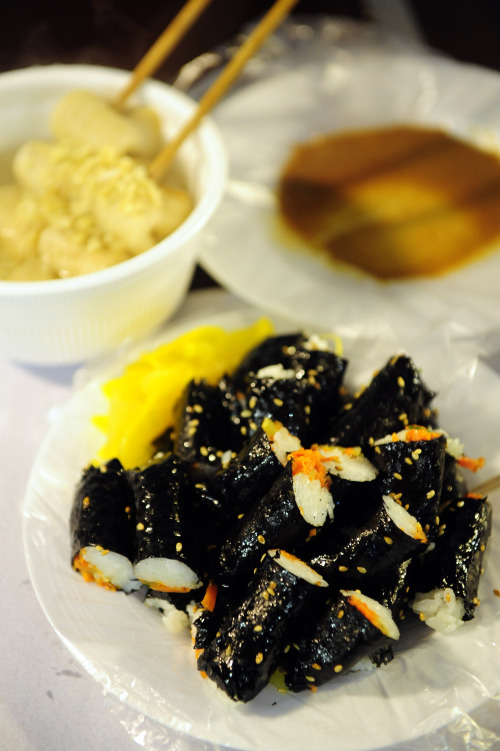
Korean snacks straight off the griddle at Gwangjang Market’s food bazaar
A buoyant air of camaraderie pervades Gwangjang Market’s famed food bazaar.
Essentially an X-shaped convergence of stalls and sit-down eateries, at night the food-packed turf is brimming with regulars and tourists who have come to rub shoulders, clink glasses and have a good time.
Part of the fun is the spectacle of watching grub being whipped up on the premises.
At stalls from left to right, huge millstones grind mung beans. The crushed beans ooze out from between the two stones, creating a frothy, creamy base for one of the center’s specialties: bindaetteok (mung bean pancakes).
A buoyant air of camaraderie pervades Gwangjang Market’s famed food bazaar.
Essentially an X-shaped convergence of stalls and sit-down eateries, at night the food-packed turf is brimming with regulars and tourists who have come to rub shoulders, clink glasses and have a good time.
Part of the fun is the spectacle of watching grub being whipped up on the premises.
At stalls from left to right, huge millstones grind mung beans. The crushed beans ooze out from between the two stones, creating a frothy, creamy base for one of the center’s specialties: bindaetteok (mung bean pancakes).

Stalls running throughout the center of the covered streets sport piles of glistening, arm-sized “king” sundae (blood sausage), pig’s trotters and hot pans of tteokbokki (spicy rice cakes); and at spots scattered here and there, patrons line up for those mini dried laver rolls dubbed “mayak (drug)” kimbap, thus named because of their reputed addictiveness.
While these appear to be among the most common eats available here, the food marketplace dabbles in a wide array of Korean snacks and dishes, including kalguksu (hand-cut noodles) and porridge.
“I come here for the diversity of the items,” Lee Hae-young, 34, summed up her take on the allure of Gwangjang Market’s food bazaar. “There is a lot to eat.”
Lee revealed that she has been frequenting the same shop, Jangchung Nakwon Tteok Jip, for its chewy, bean-filled bukkumi (folded pancakes) for two years and counting.
“I really like this place’s bukkumi,” she said while watching owner Ki Eun-ae skillfully prepare the traditional snacks on a hot griddle.
Ki has been selling bukkumi ― red bean paste-filled sorghum and white bean paste-filled sticky rice versions ― at the 40-year-old rice cake shop for 15 years.
“My mom used to make this as a snack for me,” Ki, 64, said, as she folded the bean paste-filled sorghum pancakes in half with her spatula and pressed down.
“Mom” is a word that springs from the lips of many food bazaar veterans here.
Mo-nyeo Mayak Kimbap owner Yoo Yang-sook inherited her trade from her mother, while Halmeoni Jip Sundae owner Oh In-sook took over the sausage business from her mother-in-law.

“This is a second generation operation,” said Oh, 62.
The 50-year old establishment specializes in Hamgyeong Province-style housemade sundae.
“About 12 ingredients go into our sausages,” Oh revealed, before explaining why they have two kinds of North Korean-style sausages on their menu.
“We sell both makchang, which is big and yellow, about 50 centimeters long, and daechang, medium-sized, sundae.
“Hamgyeong Province-style makchang sausage is called abai sundae,” she elaborated, describing how this particular style of sundae is nutty, chewy and soft.
After having sold her wares from a stall for 17 years, Oh opened a second and much larger sit-in spot last year. Oh is not the only business to expand.
Park Ganae Bindaetteok boasts around four outposts, while Mo-nyeo Mayak Kimbap sports two. The first is situated elsewhere in Gwangjang Market, the second inside the food bazaar.
While juggling an endless stream of take-away orders at the first outpost, Mo-nyeo Mayak Kimbap’s Yoo explained how they make their small, dainty kimbap and its piquant dipping sauce.
“My mom originally made that sauce for the rice-stuffed tofu skin pouches, but it ended up getting paired with the kimbap,” said Yoo, 50.
The combination is spot on.
The kick from the slightly spicy mustard-soy sauce gives the sesame seed-sprinkled rolls, which have been filled with a simple mixture of rice, carrots, pickled daikon radish and leeks, a pleasant punch.
The no-frills snack has visitors lining up at both spots for a taste.
In fact, most places have crowds perched up onto the stalls’ benches, or people waiting benches, or people waiting for a piping hot mung bean pancake, fresh off the griddle, or some other tasty tidbit.
The busy, bustling atmosphere is infectious and boisterous, and as dusk gathers, more and more people pile into the covered alleys, heightening the warm ambience of the marketplace’s lamp-lit space.
Considering the steady stream of traffic and the expansion of businesses left and right, it looks like Gwangjang Market’s eateries are doing well.
“Food businesses, eats are growing,” said Cho Byung-ok, director of the Jongno Gwangjang Traditional Market Merchant Association.
Cho noted an increase in the market’s food bazaar customers following the restoration of Cheonggye Stream in 2005.
“Now we get a lot of young visitors,” Halmonie Jip Sundae’s Oh agreed.
Park Ganae Bindaetteok owner Park Geum-soon also noted more overseas tourists hitting the marketplace, drawn, perhaps, by the prospect of enjoying wallet-friendly Korean fare served up in generous portions.
For example, Halmonie Jip’s daechang sundae replete with trimmings costs 6,000 won, one of Park Ganae’s thick, large bindaetteok 4,000 won, Mo-nyeo’s mayak kimbap 2,500 won, and one bukkumi from Jangchung Nakwon Tteok Jip 2,000 won.
Kwangjang Market also boasts a longstanding history that goes as far back as 1905 and is a place where you can purchase a versatile array of wares, be it hanbok, household goods, ceramics or food.
The market’s vintage clothing, said Cho, has also been attracting the younger crowd, pointing to a retro trend that is in keeping with the storied environs of the more than 100-year-old space.
To get to Gwangjang Market’s food bazaar go to Jongno-5-ga Subway Station Line 1, Exit 10. Make a U-turn and enter through the North 2nd Gate.
By Jean Oh (oh_jean@heraldcorp.com)
-
Articles by Korea Herald












![[Today’s K-pop] BTS pop-up event to come to Seoul](http://res.heraldm.com/phpwas/restmb_idxmake.php?idx=644&simg=/content/image/2024/04/17/20240417050734_0.jpg&u=)





![[KH Explains] Hyundai's full hybrid edge to pay off amid slow transition to pure EVs](http://res.heraldm.com/phpwas/restmb_idxmake.php?idx=652&simg=/content/image/2024/04/18/20240418050645_0.jpg&u=20240419100350)

![[Today’s K-pop] Zico drops snippet of collaboration with Jennie](http://res.heraldm.com/phpwas/restmb_idxmake.php?idx=642&simg=/content/image/2024/04/18/20240418050702_0.jpg&u=)